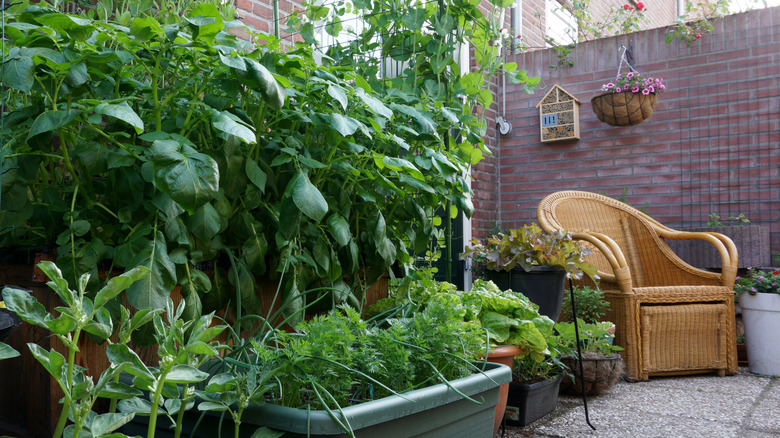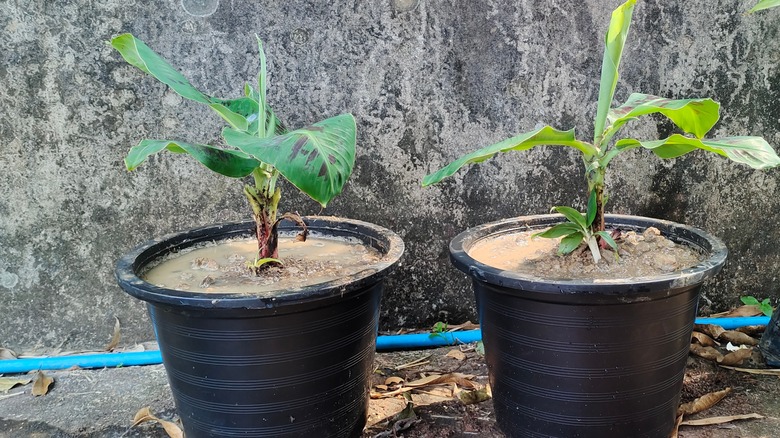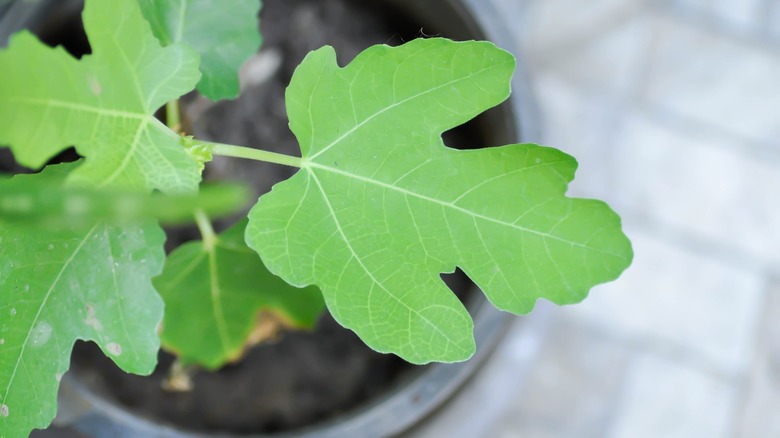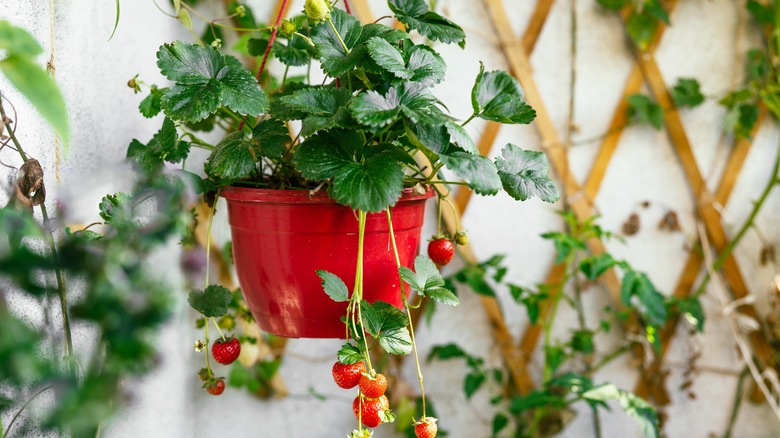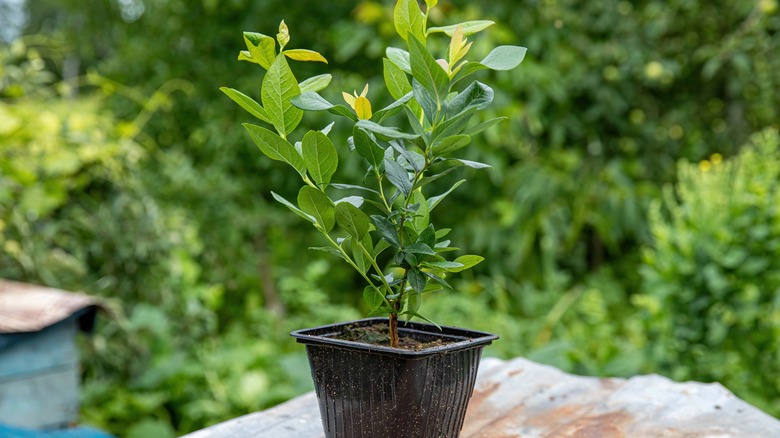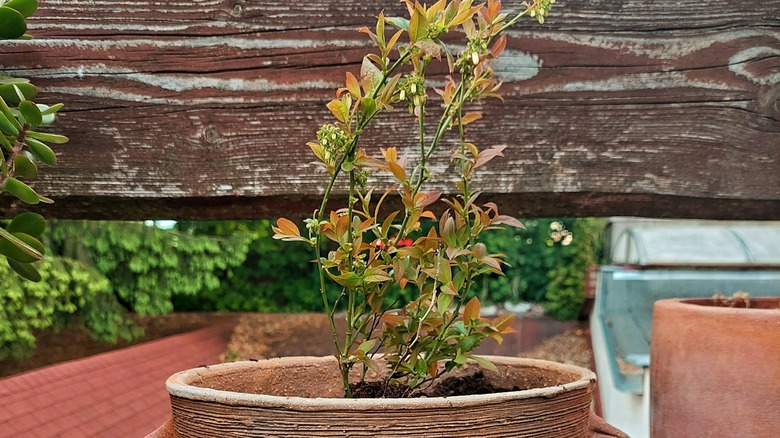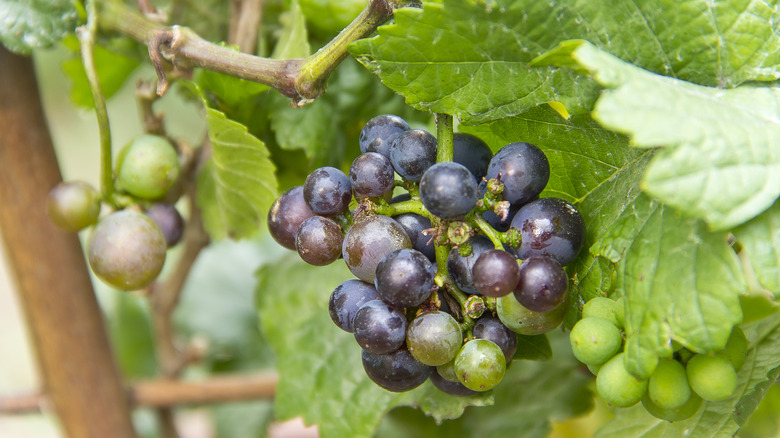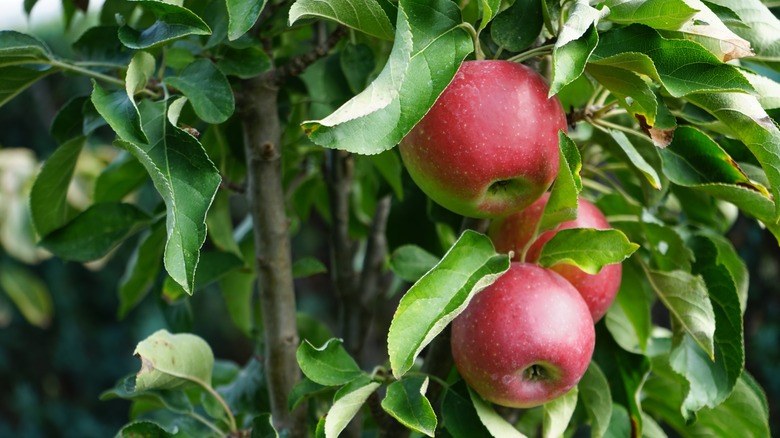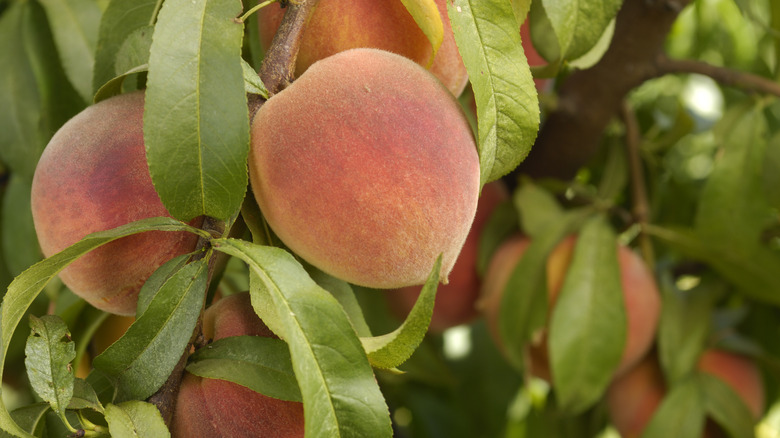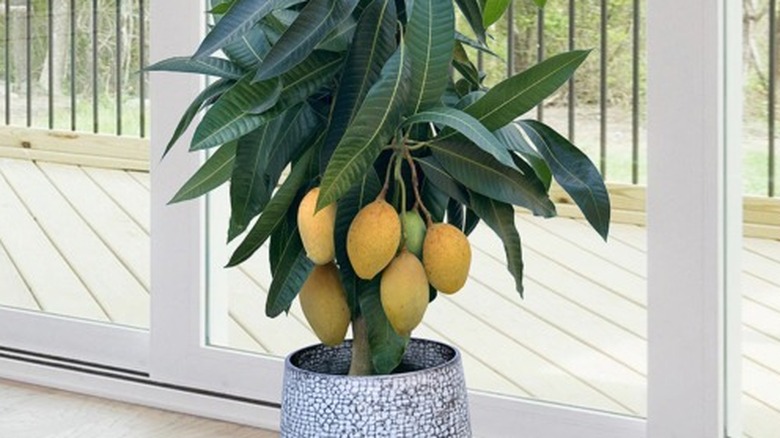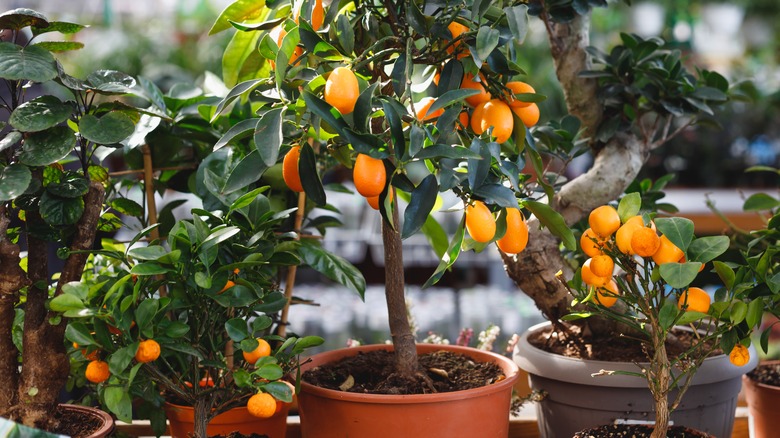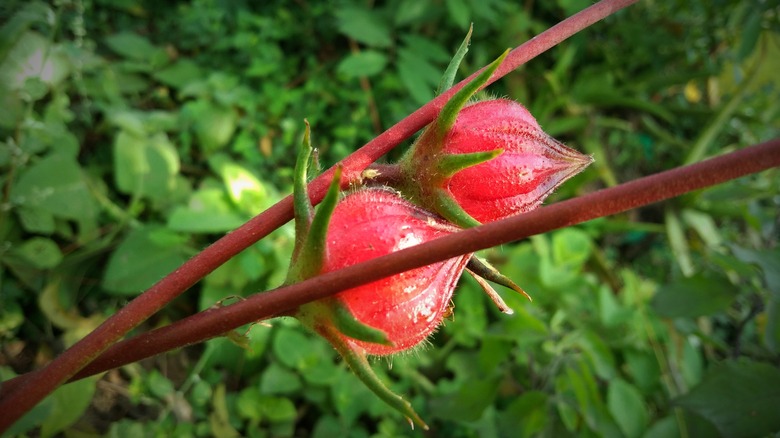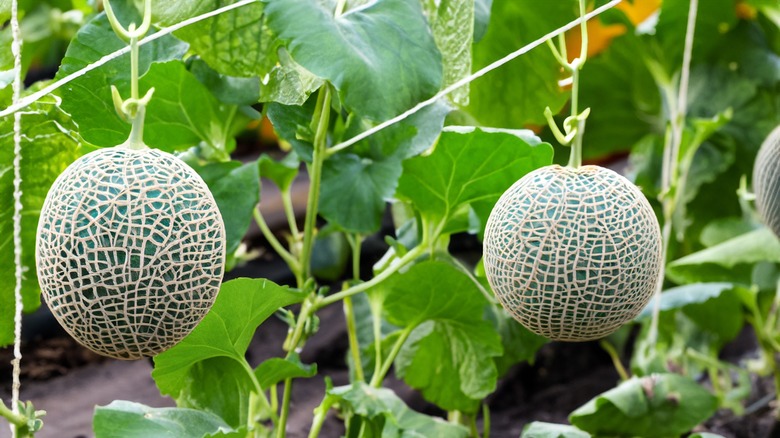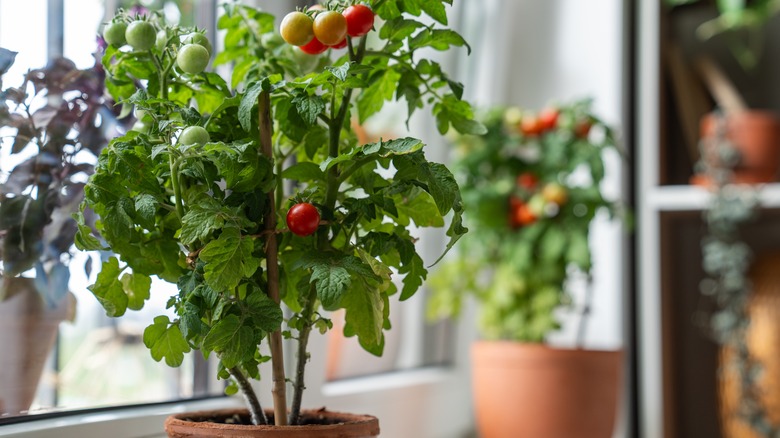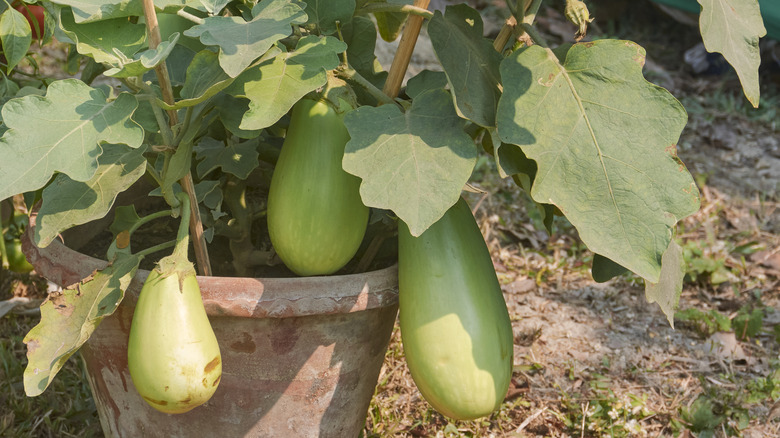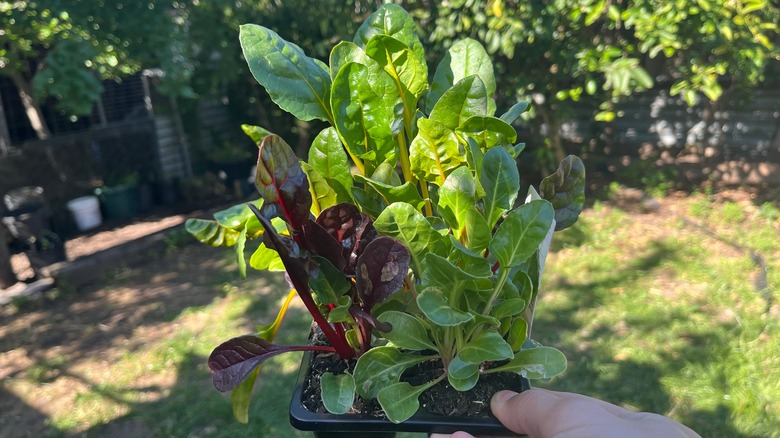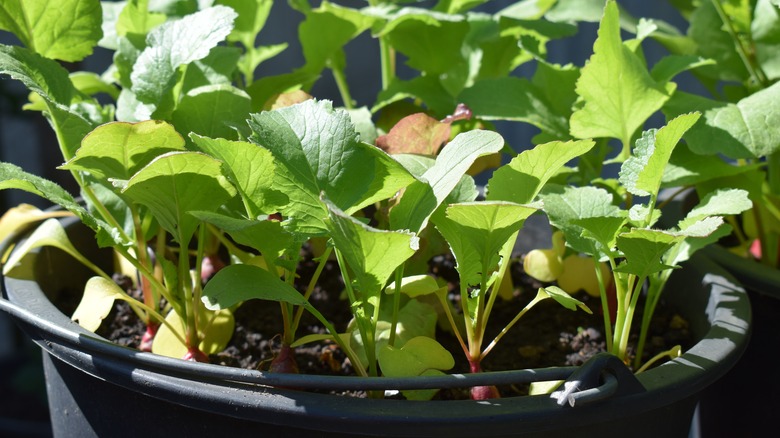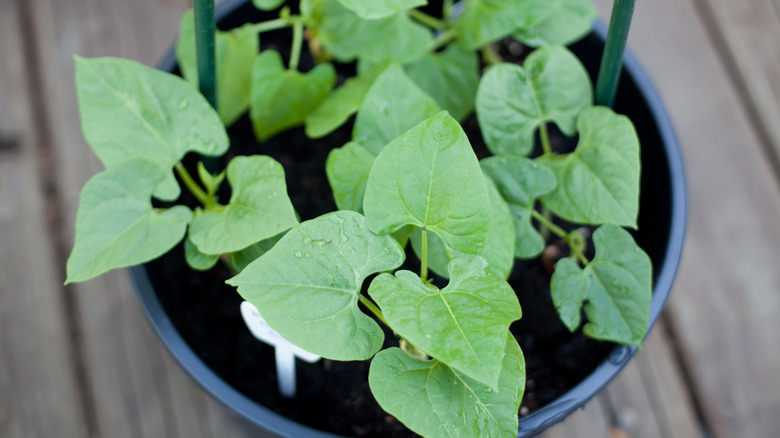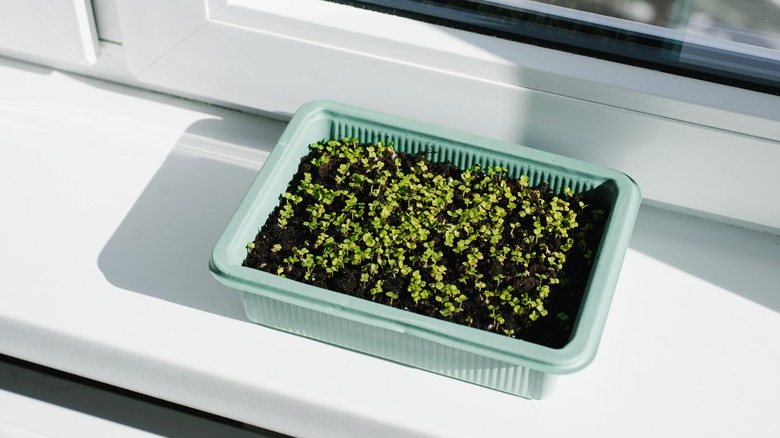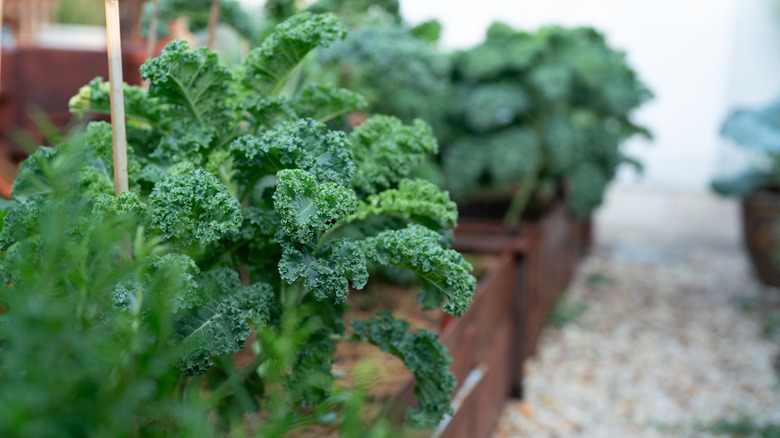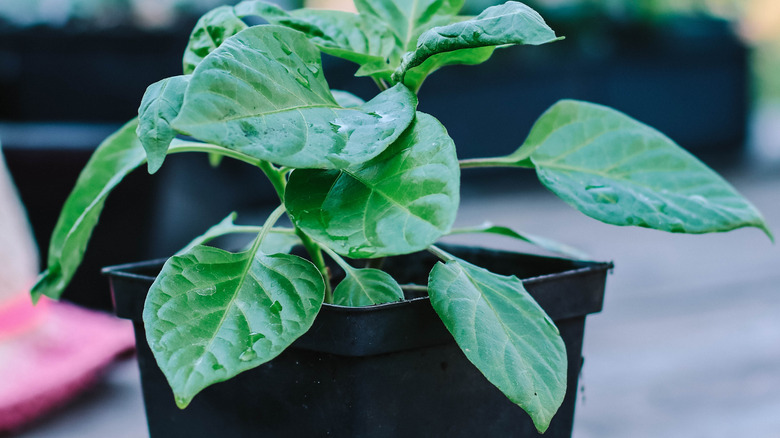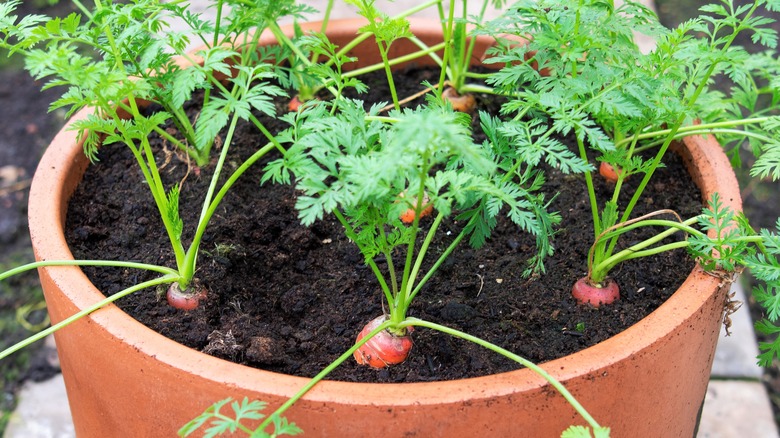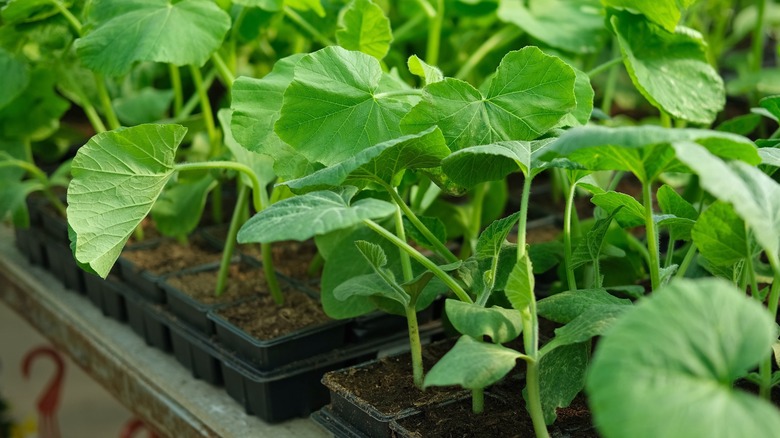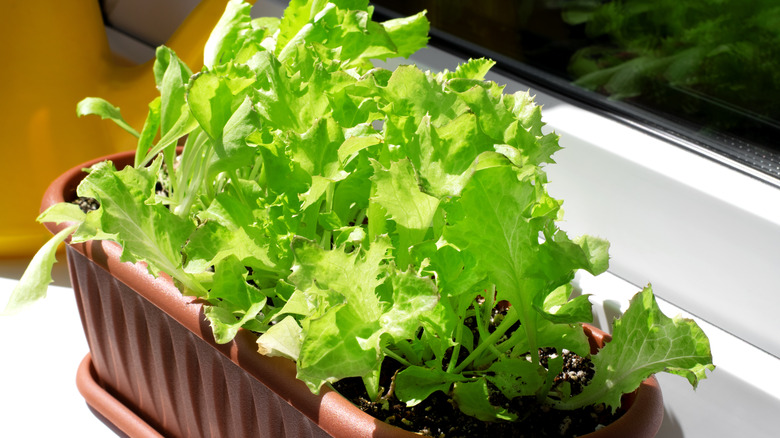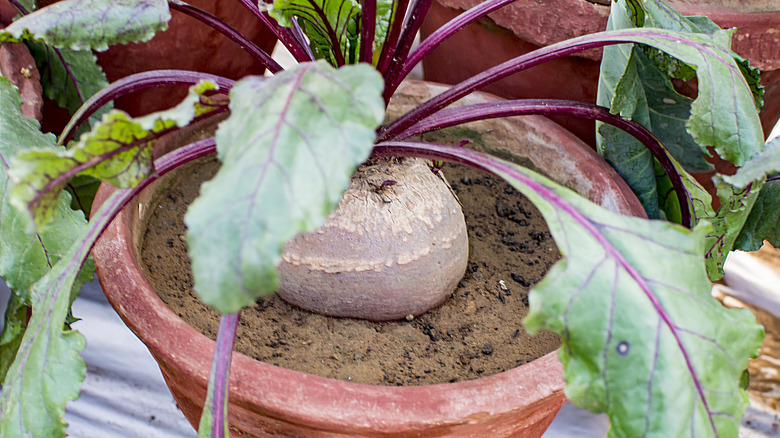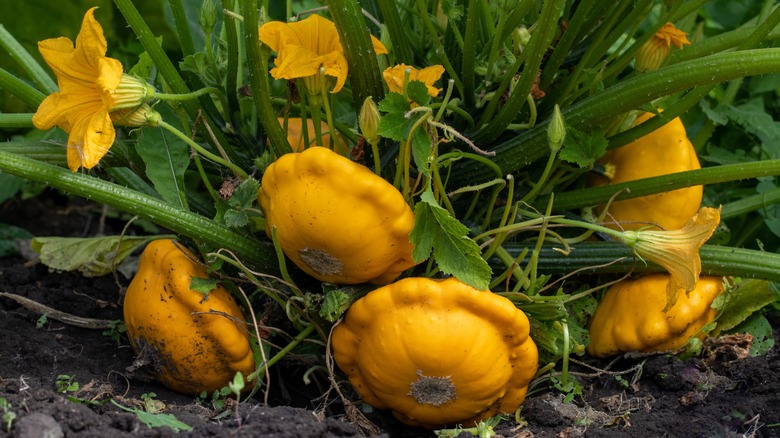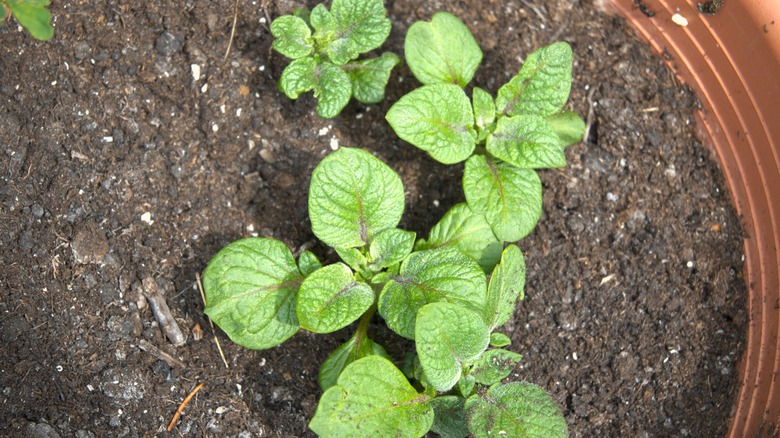26 Fruits And Veggies You Can Grow With Limited Space On A Patio
A lack of a sprawling yard is no reason to deprive yourself of homegrown produce. As long as you have an underutilized space on your patio — no matter how small — you can use it for gardening. Of course, to get the most value, you'll be well served to keep your eyes on compact varieties, as this will open the space to grow several fruits and veggies. Another option is to think vertically and make use of wood fences or DIY trellises to support vining plants. Once you feel confident about your skills, you can indulge in succession and companion planting for year-round harvests.
Before you begin planting, keep in mind that containers work a tad differently from garden beds. Since the amount of soil is limited, they dry out quickly, which means you'll need to water them frequently. You'll also need to supplement them with fertilizers or compost. Since we usually add soilless blends that only include small doses of pre-mixed fertilizer, plants can run out of nutrients without additional feedings — even more so, if they take a long time to mature. On the plus side, though, you'll be dealing with fewer weeds and pests. In especially hot climates, consider lifting the containers a few inches off the cemented ground to minimize heat transfer. If you're dealing with frost-tender varieties, grow them in rolling planters, so you can easily move them indoors. With general care tips explained, let's discover the different fruits and vegetables you can grow in space-constrained patios.
Bananas
Add a touch of tropical to your patio with banana plants (Musa spp.). Not only will they regale you with their ornate, lush foliage, but if you live in a frost-free area, you can experience their tasty fruit, too. Be sure to choose a deep container that's shielded away from winds. Given their tropical background, you must give them at least 12 hours of direct sunlight and water generously, or the fruit will be inferior. Since they're heavy feeders, apply a liquid fertilizer weekly. 'Super Dwarf Cavendish,' 'Dwarf Cavendish,' and 'Dwarf Orinico' are ideal cultivars for patio containers.
Figs
Surprisingly, figs (Ficus carica) grow better fruit in containers than they do in gardens, and that's because they like it when they grow root-bound. So, if you live north of USDA Hardiness Zone 7, where these plants die back in winter, you can still grow them in containers and place them on the patio during the growing season. Figs require moist, rich soils, so be sure to plant them in a quality potting mix and water consistently, especially during summer heat. They need full sun and are self-fertile. In addition to the self-pollinating fruit tree variety 'Brown Turkey,' 'Brunswick' and 'Petite Negri' are good contenders.
Strawberries
When you're strapped for space, want fruits, and still want to keep things ornamental, consider growing strawberries. Rather than June-bearing varieties, opt for everlasting or day-neutral varieties, as they entail less maintenance and keep producing fruit for much of the season. 'Ozark Beauty,' 'Everest,' 'Albion,' and 'Seascape' are some nice cultivar options for patio containers. Since strawberries spread laterally, they require a container at least 12 inches wide so you can accommodate about four plants or more. Locate the containers where they receive over six hours of daylight. Keep the soil moist by watering daily or more frequently during hot summers.
Blueberries
As blueberries tend to stay compact, they can be grown in patio containers. However, limit yourself to semi-dwarf or dwarf cultivars, such as 'Sunshine Blue,' 'Midnight Cascade,' or 'Jelly Bean,' for the best results. Blueberries require highly acidic soils, so choose your fertilizers accordingly or consider adding peat moss to the potting soil. You'll also need to plant at least two different varieties with overlapping flowering times to promote cross-fertilization. To get the fruit at the earliest, look for three-year-old plants and remove their flowers in spring to divert resources to root growth and fruit production.
Raspberries
When you're short on space but your patio receives plenty of sunlight, consider growing raspberries. To accommodate their root system, plant them in a container that's about 2 feet deep. Since raspberries require good drainage, it's best to use bulk mixes containing potting soil, perlite, and ground bark. Either look for summer-bearing red or yellow varieties, including 'Cascade Delight,' 'Cascade Gold,' and 'Meeker,' or stick to the short, thornless Brazelberries series featuring 'Raspberry Shortcake.' If you're buying one-year-old plants, you'll have to wait at least another year for the fruit.
Pixie grapes
If you're looking for a short-and-sweet plant to deck your patio, look no further than Pixie grapes. They grow no taller or wider than 24 inches, which also explains why they can do with little to no pruning. But because they're a vining plant, you'll need a 4-foot-high vertical support in place. To avoid overheating them, select wood planters that can support their mature size. Also, spread a 2- to 3-inch-thick mulch layer for moisture retention and for enhanced aesthetics. Although pixie grapes are self-fertile, bumping the vines against each other when they're actively producing flowers can improve fruiting.
Columnar apple trees
Although the fruits from columnar apple trees aren't on par with the supermarket apples, they are a good place to start if you want to produce fruit in a limited space. These trees grow pole-like, extending at most 3 feet wide, but may require staking to hold them up in windy locations. Their foliage is cold-hardy through 15 degrees Fahrenheit, while their roots can survive freezing temperatures with mulch. Grow them in 20-inch-wide and equally deep containers, exposed to full sun. 'Urban Apples' and 'Spire' series are popular options. You'll need to find them a compatible companion for fruit production.
Peaches
If you don't have the space for a pollinating companion, consider growing peaches instead, as most varieties are self-fertile. Look for patio, dwarf, or miniature peach options, such as 'Bonfire,' 'Pix Zee,' 'El Dorado,' 'Bonanza,' or 'Golden Glory.' But do check their chilling hour requirements before planting, especially if you live in the south, or they won't fruit. Plant them in full sun, facing southwest or south walls. It's worth noting that many of these peaches are more suited for jams and preserves rather than as delicacies consumed fresh off the tree.
'Pickering' mango
In a south-facing patio where temperatures don't dip below 60 degrees Fahrenheit, growing 'Pickering' mango (Mangifera indica 'Pickering') is an option. Since you can prune it to under 10 feet, it doesn't look unwieldy in small spaces. Flowers set in during the winter-spring transition, making way for red-blotched, yellow-skinned fruits in the summer. Stripped of most fibers, the fruit tastes devilishly sweet with a dash of coconut. Although it's an early bearer, you must remove all fruits until it's a few years old to promote sturdy growth. 'Pickering' shows some resistance to black spot and anthracnose.
Dwarf citrus
If your patio receives over eight hours of direct sunlight and is shielded from winter winds, you may have luck growing dwarf citrus varieties on your patio. Their yellow or orange orbs look quite ornamental, parked in repurposed whiskey barrels or wooden urns. Use varieties with 'Flying Dragon' as rootstocks, as they usually stay compact. In cold climates, start with the hardiest options, like kumquat, Meyer lemon, satsuma, or calamondin. Tangerines, Bearss limes, and citro are more suitable in milder climates. Use these tips and tricks to keep your potted citrus trees thriving over the years.
Florida cranberry
An okra relative, Florida cranberry or roselle (Hibiscus sabdariffa) is a vegetable whose leaves are consumed as a spicy substitute for spinach in some regions. Although hardy through zone 3, this edible doesn't get sufficient sunlight in zones colder than 8 to produce flowers, which can be disappointing as they can be used for jellies and preserves. Down south, be sure to start the seeds by May so you can enjoy their fruit in November. However, monitor their growth for iguanas if they're active in your area. Full sun exposure and regular watering are a must for healthy growth.
Melons
Admittedly, melons are not the easiest fruits to grow in containers because they can get quite big. But if you start with miniature varieties, such as 'Tasty Bites F1,' 'Sugar Baby,' 'Organic First Kiss F1,' or 'Minnesota Midget' cantaloupe (which also happens to show resistance to fusarium wilt), you have greater chances of growing this summery sweet fruit. Pop a couple of seeds in a container that's at least 5 gallons, and thin seedlings later. Since melons grow vines, be sure to give them latticed support and use this pantyhose trick to support the fruit. Hand pollinate if bees are skipping your patio.
Tomatoes
Those who've been gardening for a while will probably need no introduction to the world of container-grown tomatoes. After all, they're the most popular go-to, right after herbs. Apart from cherry tomatoes, the best types of tomato for your container garden include 'Bush Early Girl,' 'Patio Princess,' and 'Super Bush Hybrid.' They all have excellent flavors and maintain a small stature. However, as they produce profusely, you'll need to support their stems or they'll break under the fruits' weight. Pot these varieties in a container that's at least 14 inches wide to encourage more fruiting. Also, feed a liquid fertilizer every week.
Eggplant
Certain eggplant varieties, such as 'Patio Baby,' 'Calliope,' 'Gretel,' 'Fairy Tale,' and 'Kermit,' can be successfully grown in containers. Most of these varieties are early producers, with their seed-to-fruit cycle terminating between 45 and 64 days. Save for 'Patio Baby,' whose fruits are the characteristic purple hue, the rest feature white or variegated fruits, further drumming up visual interest. Given their small size, you won't have to support their branches to keep them upright. But you must give their flowery stalks a good shake to encourage pollination. Lucky for us, they all produce abundantly, so a lone plant or two will keep you sorted for the season.
Swiss chard
Popular in the gardening parlance as a "beet without a bottom" because of their shared similarities, Swiss chard is another vegetable that deserves a spot on your patio. The flamboyantly colored stems and leaves on varieties like 'Rainbow' and 'Bright Lights' add a gorgeous pop of color, while still being edible. Swiss chard requires six hours of direct sunlight at a minimum and can be planted 6 inches apart when you desire a heavy harvest. Make sure their pot is a minimum of 10 inches deep to comfortably fit their extensive root system.
Radish
Love your salads? How about growing some radishes for that delicious crunch? As radishes grow quickly, becoming mature in under 35 days, you don't have to grow them in a dedicated planter. Instead, sprinkle a few seeds in the margins of any veggie container, so long it's at least 6 inches deep, and repeat this action every 10 days or so for a successive supply. That way, you can rest assured that your crop won't grow woody because of being left in the soil for too long. Radishes require over eight hours of direct sun exposure and constantly moist soils.
Beans
In case you've a way to support them up, you can grow pole beans in narrow planters on your patio. Otherwise, choose bush beans, as they naturally keep small and won't overwhelm the space. Not to mention, the gestation period for the beans is much shorter in the case of bush varieties. Beans require over eight hours of direct sunlight and should be kept well-watered. Although they aren't too fussy about fertilization, doing so would ensure a good harvest. 'Bush Blue Lake', 'Roma II', 'Cherokee Wax,' 'Royal Burgundy,' 'Gold Crop,' 'Pinto', 'Red Kidney', and 'Black Bean' are great varieties.
Arugula
What makes arugula a strong contender for patio containers is its minimal space requirement (no more than an herb's) and ease of planting. All you have to do is sow a few seeds that you can harvest in a month or two, and keep planting them successively at three-week intervals until frost hits. Arugula fares best in full sun exposure. However, during extreme summer heat, it will benefit from afternoon protection and regular watering to prevent premature bolting. Please note that arugula that are planted in massed concentrations can attract flea beetles. They're cold-hardy through zone 3 and can withstand light freezes.
Kale
Prized for the sweet taste of their lush leaves, kale is one of those vegetables you should wait to harvest after a big frost, as the cold temperatures make them sweeter. However, they can be grown throughout the growth season, which makes them suitable for patios for continuous visual interest. Edible varieties, such as 'Redbor' or 'Dwarf Blue Curled Vates,' are naturally compact and add an ornamental touch with their brightly-hued leaves. As kale adapts to most conditions, it's easy to seed, though you must wait nearly three months to harvest its leaves.
Peppers
If you've got the space to keep a 5-gallon bucket or container on your patio, experiment with peppers. Depending on the chosen variety, you may wind up with peppers that later color-shift into red, yellow, purple, or brown pods with varying shapes and sizes, making the space pop. However, if you have a short growth season, check the labels for days to maturity and make sure they're under 120 days for a successful harvest. Peppers require full sun exposure. For improved drainage, use a soilless potting mix and raise the container a few inches above ground — you could place it over bricks to allow the excess water to seep out.
Carrots
You must've heard that to make growing carrots a breeze, you should start them as seeds rather than purchase their transplants, as they grow a deep taproot. However, this can become a problem if you grow them in pots that aren't deep enough to hold their root system. To avoid this issue, check your desired carrot's final length and select a pot that's around 1½ times deeper than that. Afterward, drop the container in a sunny spot and freely sprinkle the seeds. 'Orbit,' 'Short'n Sweet,' 'Royal Chantenay,' and 'Little Finger' are some options worth a try.
Cucumbers
Like beans, cucumbers have pole and bush varieties. So, if you're keen on gardening vertically by propping a trellis or a tomato cage, add climbing varieties to your planters. Otherwise, play safe with bush varieties. Ensure the chosen container is about 20 inches wide and drains sufficiently well. Offer southern sun exposure to easily meet their light and heat requirements. Do note that cucumbers require ample care. You may need to water them every other day and apply a slow-release fertilizer every month until they're ready for harvest. Container-worthy, early-maturing varieties include 'Lemon Cucumber,' 'Diva,' 'Unagi, and 'Japanese Climbing.'
Lettuce
Another vegetable that's certain to become the highlight of your patio garden is lettuce. The tiny, layered heads popping out from the soil look quite pretty, and don't even require much effort or time on your part, as they easily adjust to most conditions, including light frosts and partial shade. But to get multiple harvests, aim to plant lettuce in the potting mix in early spring and again in late summer. Alternatively, you may plant several varieties with varying times to maturity for a continued harvest. Your options include 'Oak Leaf,' 'Salad Bowl,' 'Valmaine,' 'Buttercrunch,' and 'Summertime.'
Beets
As beets remain compact, growing about 18 inches high and half as wide by maturity, they make decent container plantings. Plus, thanks to their ability to withstand cold, humidity, and heat, you can grow them outdoors across all zones from 2 to 11. As beets are shallow-rooted, you can place them in a 10-inch-deep pot. Shaded spots aren't a problem, as long as they're exposed to the sun for about three hours. Chioggia beets will lift the scape with their red-white variegation. But if you've been holding out on beets because of their strong taste, switch to milder, heirloom varieties like 'Albina Vereduna.'
Bush squash
While summer squash plants typically grow large, there are some bush varieties, such as Fancycrook, Gentry Goldbar, Zephyr, and Crookneck, suitable for container cultivation. Most of them are early bearers and can be harvested in under 50 days. However, for a rich harvest, you must grow them in a large, well-draining container, at least 20 inches wide, and water frequently. Go higher if you wish to plant multiple crops, as they must be spaced 12 inches apart. Give them full sun exposure and apply an all-purpose fertilizer every month, but for the last month, when they're due for harvesting.
Potatoes
You can grow delicious potatoes in containers for a fresh and easy harvest, but make sure they're at least 18 inches wide and twice as deep. If not, the veggies won't have sufficient space to spread their roots, which will reduce your crop. Rather than seeds, potatoes are started with seed potatoes, which are basically tubers sliced into small segments with a couple of eyes. Unless you're buying organic potatoes from the supermarket, don't DIY and grab a few tubers directly from the nursery. Varieties like Epicure, Irish Cobbler, Kennebec, and Russet Burbank perform great in containers.
